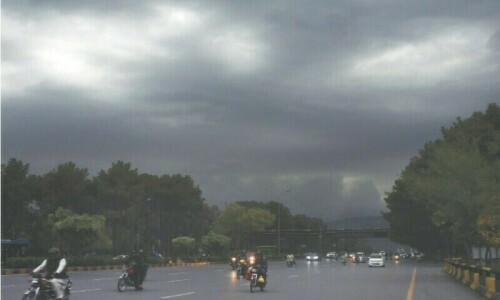PARIS, Jan 28: Astronomers have observed a planet some 200 light years from Earth that, for a few hours, becomes 700 degrees Celsius hotter every time its elliptical orbit brings it close to its sun.
The scientists, in a study released on Wednesday, said they had generated the most realistic images ever captured of the exoplanet, the name given to planets outside our Solar System.
They used infrared data collected from Nasa’s space-based Spitzer telescope to gain pictures of a strange world exposed briefly to an inferno.
One image shows a thin blue crescent on the “dark” side of the planet, opposite its star, while the scorched side glows a deep, crimson red.
Known as HD80606b, the planet is a giant ball of gas that has four times the mass of Jupiter, the biggest planet of our system.
Researchers led by Gregory Laughlin of the University of California at Santa Cruz analysed data collected in November 30 hours before, during and after HD80606b’s closest approach to its star.
From the telescope’s vantage point, the planet passed behind the star — an event called a secondary eclipse — just before reaching its maximum temperature of 1,227 C (2240 F), hotter than molten lava.
It was an unexpected stroke of luck, making it possible to measure the exact temperatures of the star and the planet separately.
“This is the first time that we’ve detected weather changes in real time on a planet outside our solar system,” said Laughlin. “The results are very exciting because they give us important clues to the atmospheric properties of the planet.”
As the atmosphere heats up and expands, it produces fierce winds — moving at five kilometres per second — that flow away from the day side towards the night side.
The planet’s rotation causes the winds to curl up into large-scale storm systems that gradually peter out as temperatures cool, Laughlin said.
HD80606b swings around its sun in an elliptical orbit every 114 Earth days. It is one of about a dozen so-called “hot Jupiter” extra-solar planets which spin on their axes in such a way that the same surface is always facing their respective stars.
The photo-like images were generated by a computer programme that calculated the colour and intensity of light coming from the glowing planet.
“These images are far more realistic than anything that’s been done before for extra-solar planets,” said UCSC researcher Daniel Kasen, who developed the programme.
When closest to its star, the sunlight beating down on the planet is more than 800 times stronger than at the far end of its egg-shaped orbit.—AFP












































Dear visitor, the comments section is undergoing an overhaul and will return soon.